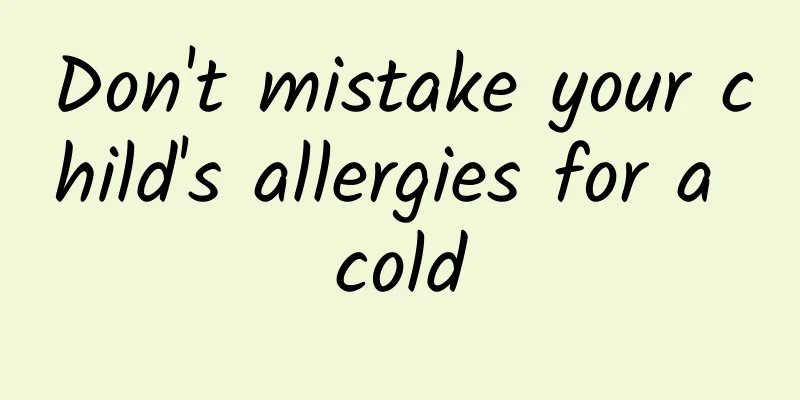Don't mistake your child's allergies for a cold

|
Less than half a month after the fall semester started, the number of children in the hospital has increased. Parents who take their children to the hospital almost all say the same thing: the children have been fine at home for the past eight months and have not been sick once. How come they are sick just a few days after the start of school? Is it a special virus? Is there something wrong with the school environment? Or is it that the teachers don't take good care of the children? None of them. This is because the children have just started school and they are caught up in the fall allergy season. September 1 to 7 was a week when grass pollen (wormwood, quinoa, humulus, ragweed, amaranth, etc.) concentrations in northern China were off the charts. The allergenic pollen concentration index jointly released by the Beijing Meteorological Bureau and Tongren Hospital showed that on a certain day in early September in Beijing, except for Fengtai and Changping districts, the pollen concentrations in other urban areas were higher than 500 grains/1000mm*24 hours (above level 5), which was very high and extremely high. The concentration in Haidian reached 1000, and the concentration in Chaoyang District was off the charts to nearly 1800. In the previous week, Haidian District and Chaoyang District had been at a high level above level 5. Pollen allergies are more severe in autumn than in spring In spring, there are flowers everywhere, so pollen allergies are easy to understand. In autumn, when all the flowers have bloomed, why are there more people with allergies and more severe allergic symptoms? Because most of the pollen in spring comes from bright flowers, most of which are insect-pollinated flowers, which rely on insects for pollination. The pollen particles of insect-pollinated flowers are relatively large, and the pollen is easy to settle after falling off the flowers, and is less likely to be blown away in the wind; the amount of pollen is also relatively small. Therefore, large flowers cause relatively few allergies. Pollen in autumn mainly comes from inconspicuous grasses such as Artemisia, Chenopodiaceae, and Humulus. They are strong and can be found everywhere in the wilderness, fields, and community yards. These grasses also have very small flowers, which are called wind-pollinated flowers, that is, pollination is completed by wind. The pollen particles of wind-pollinated flowers are small and dry, and are easily dispersed in the wind; and there are more wind-pollinated flowers, and the pollen is small and abundant, which is more likely to cause allergies. What you thought was a cold might be an allergy Some children who have come to the hospital for treatment recently have symptoms that are very similar to those of a cold, including runny nose, sneezing, and coughing. Some children also have a mild fever, which are often misdiagnosed as a cold by their parents. In fact, it is not a cold, but an allergy. The symptoms of the two are very similar. Especially in the first two or three weeks of school, due to the high concentration of allergens, it is natural that many children have allergic symptoms. Especially if the child has gone hiking or picnics before the onset of symptoms, or lives in an area with dense grasses, and the symptoms are correlated with the pollen concentration index (high pollen concentration means severe symptoms), you should consider whether it is an allergy. If necessary, you can take some anti-allergic drugs. If the symptoms are significantly relieved after taking them, it is also evidence of allergy. Allergic diseases are not easy to avoid during the allergy season. Even if school is not open, it is estimated that many children will have symptoms. Of course, if we are in a quarantine state like in March, there will be fewer cases of illness. Because if you rarely go out, you will have fewer chances of contact with allergens, and the possibility of causing allergic symptoms will be reduced. After children go to school, they spend more time outdoors and have more chances of contact with allergens, so the number of allergy patients will naturally increase. To deal with autumn allergies, the key is to prevent them in daily life The most common allergy at present is nasal allergy, the main symptoms of which are sneezing, runny nose, itchy nose, nasal congestion, and some people may have nosebleeds. There are also many cases of eye allergy, the main symptoms are itchy eyes. Some children blink frequently because of itchy eyes, or their eyes are obviously congested. There are also frequent coughing. Since there is a lot of pollen in autumn and it is easy to cause allergies, what should people with allergies or who are prone to allergies in autumn do? 1. Pay attention to the autumn pollen index. Data show that the peak season for summer and autumn pollen in northern China is from mid-to-late August to mid-September. During this period, parents should pay more attention to the pollen index and its changing trends released by the Meteorological Bureau, and pay attention to the pollen concentration, level, type and specific figures in their area. 2. Avoid appropriately. Paying attention to the pollen index is to take appropriate avoidance measures and reduce going out and staying outdoors during the peak pollen period. If you must go out, you must take appropriate measures after returning. 3. Wear a mask. This year, due to the epidemic, everyone actively wears masks, which reduces the number of people with allergies and alleviates allergic symptoms. So if you go out in autumn, remember to wear a mask. 4. Wash the nose and eyes promptly after returning from outside. If the child has a lot of outdoor activities that day, there is a lot of grass around the campus or kindergarten, and the weather is breezy (there is a lot of pollen in the air), urge the child to wash his face, rinse his mouth, and wash his nose after returning home to reduce the time of allergen stimulation. Children can wash their noses (normal saline nasal spray or nasal irrigator) after returning from outside; artificial tears can be dripped into the eyes for cleaning; also pay attention to washing the face and rinsing the mouth. 5. Take anti-allergic drugs in advance. For people with autumn allergies, the latest treatment recommendations are: ① Use allergy drugs such as loratadine and zoltec half a month before the onset of the disease, which can greatly shorten the onset period, reduce the severity of the disease, and even avoid the disease. ② Actively use nasal sprays or respiratory aerosols (or atomization). If the child has obvious nasal allergy symptoms, it is recommended to use nasal sprays under the guidance of a doctor. ③ If sensitive coughs and wheezing occur, use respiratory aerosols or atomization treatment under the guidance of a doctor. There are several main types of nasal sprays: one is hormone-based, the second is to relieve nasal sensitivity, and the third is to relieve nasal congestion. After using nasal sprays to relieve nasal congestion, children's symptoms are often relieved quickly, and most parents are willing to accept it. However, parents are always very worried about hormone-based nasal sprays and often do not use them according to doctor's orders. In fact, for the treatment of allergic rhinitis, it is mainly recommended to use local nasal sprays. (Chen Ying, Director of Pediatrics at Beijing New Century Women's and Children's Hospital) |
<<: The hidden nutritional expert in the vegetable world actually has six major health benefits?
Recommend
How to choose carambola? Can carambola be drunk in wine?
Star fruit, also known as carambola, is a tropica...
What are the benefits of eating fruit corn? How to choose fruit corn
Fruit corn has thin skin, is juicy and sweet, and...
What is the normal value of progesterone in ng/ml at 5 weeks of pregnancy?
If the progesterone level is low during pregnancy...
Can dandelion cure uterine fibroids?
Uterine fibroids are a benign tumor disease, so m...
What are the symptoms of pubic folliculitis? Are you affected by these?
In daily life, women must pay attention to the hy...
What to do with malignant cervical polyps
Cervical polyps are more common in married women....
Can eating chili peppers often help you live longer? A meta-analysis of 570,000 people in four countries including China and the United States
In recent years, many studies have shown that chi...
How to make nipples smaller
In daily life, female friends are all concerned a...
Can I detect pregnancy if my period is delayed for 3 days?
Previously, the web editor said that it is possib...
How long after sex can you detect pregnancy?
We all know that if a woman's menstruation st...
What should I do if it itches down there?
If you have itching problems in your private part...
Can patients with uterine fibroids eat persimmons?
Uterine fibroids are a disease that troubles many...
Beware of health risks before and after the college entrance examination
This article uses the artistic form of popular sc...
Is the rare "multiple infection" really that scary?
"Multiple infections" are rare, and many...
How long do contractions last before labor begins?
Although cesarean section technology is becoming ...









